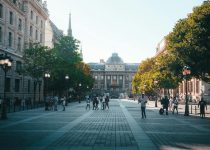What Installation Tips Make Landscape Lighting Easier?
When it comes to landscape lighting installation, you'll find that a bit of planning can go a long way. Start by mapping out your layout, identifying areas that need illumination. Choosing the right fixtures is crucial, too, as they should blend well with your landscape. But there's more to consider if you want to achieve that perfect ambiance without hassle. Let's explore some effective tips that can simplify the entire process.
Table of Contents
Key Takeaways
- Plan your layout in advance to identify key areas and fixture placements for optimal illumination.
- Choose the right type of lighting fixtures based on functionality and aesthetic appeal for your landscape.
- Opt for low-voltage or solar-powered systems for easier installation and safer DIY projects.
- Test light placement and angles before final installation to ensure the desired ambiance and effect.
- Schedule regular maintenance to inspect and clean fixtures, and promptly replace any burnt-out bulbs.
Plan Your Layout Before You Start
Before diving into your landscape lighting project, take a moment to plan your layout. Start by identifying the areas you want to illuminate, such as pathways, patios, or garden features.
Consider how you'll use these spaces, as this will guide your lighting decisions. Sketch a rough design of your yard, marking spots for each fixture.
Think about the height and angle of the lights to avoid shadows and create an inviting atmosphere. Keep in mind the balance between functionality and aesthetics; you want to highlight key features while ensuring safety.
Once you have a solid plan, you'll find the installation process much smoother and more efficient, allowing you to enjoy your beautifully lit outdoor space sooner.
Choose the Right Lighting Fixtures
Choosing the right lighting fixtures is crucial for enhancing your outdoor space and achieving your desired ambiance. Think about the overall style of your landscape and select fixtures that complement it. Consider functional needs, like path lighting versus accent lighting, to create balance and harmony.
| Fixture Type | Best Use |
|---|---|
| Path Lights | Illuminate walkways |
| Spotlights | Highlight focal points |
| Flood Lights | Provide broad coverage |
| String Lights | Create a cozy atmosphere |
| Wall Sconces | Add elegance to walls |
Consider the Power Source
Once you've selected the right lighting fixtures for your landscape, the next step is to consider the power source.
You can choose between hardwired systems and low-voltage options. Hardwired systems are typically more permanent and can handle more extensive setups, but they require professional installation. On the other hand, low-voltage systems are easier to install and safer, making them ideal for DIY projects.
Think about the distance between your power source and your fixtures; this will impact your choice. Also, consider solar-powered lights if you want a more eco-friendly option.
Whatever you choose, ensure it meets your needs and complies with local codes for safety and efficiency.
Use Quality Cables and Connectors
As you set up your landscape lighting, using quality cables and connectors is crucial for ensuring a reliable and long-lasting installation. Cheap materials can lead to issues like flickering lights or premature failures.
Investing in high-quality options will save you time and money in the long run.
Here are a few tips to consider:
- Select UV-resistant cables to prevent damage from sunlight exposure.
- Use waterproof connectors to guard against moisture and corrosion.
- Choose thicker gauge wires to reduce voltage drop and improve performance.
Test the Lighting Before Final Installation
Before you finalize your landscape lighting, make sure to test the placement of your lights.
Adjust their position and experiment with brightness levels to see what works best for your space.
This step ensures you achieve the desired ambiance and effectiveness for your outdoor area.
Assess Light Placement
Testing the lighting placement is crucial for achieving the perfect ambiance in your landscape. Before you finalize your installation, take the time to assess where your lights will shine. This step can help you avoid any surprises later on.
Consider these tips for effective light placement:
- Check the angles: Ensure the light casts soft, even illumination across your desired areas.
- Visualize the effects: Walk around your space at dusk to see how the lighting transforms your landscape.
- Adjust as needed: Don't hesitate to reposition fixtures to enhance focal points or minimize glare.
Experiment With Brightness
Once you've finalized the placement of your lights, experimenting with brightness is the next step to perfect your landscape ambiance.
Adjust the intensity of each light to see how it interacts with your surroundings. You might find that some areas need a softer glow, while others benefit from a brighter beam.
Don't hesitate to mix and match different bulb types or wattages to create depth and interest.
Take the time to walk around your space at different times of day, observing how the light changes as dusk falls.
This trial-and-error approach helps you achieve the desired atmosphere, ensuring your outdoor area feels inviting and balanced.
Maintain Your Landscape Lighting Regularly
To keep your landscape lighting shining bright, you need to maintain it regularly.
Schedule inspections to catch any issues early, clean the fixtures frequently to ensure optimal performance, and replace bulbs promptly when they burn out.
With a little effort, you can enjoy a beautiful outdoor space year-round.
Schedule Regular Inspections
While it might be easy to overlook, scheduling regular inspections for your landscape lighting is essential to ensure everything runs smoothly.
By checking your system periodically, you can catch issues before they become major problems. You'll save time and money in the long run.
Here are three key aspects to focus on during your inspections:
- Wiring and Connections: Look for any signs of wear or damage, ensuring all connections are secure.
- Fixture Alignment: Make sure all lights are pointed correctly to highlight your landscape features.
- Timer and Sensor Functionality: Test your timers and sensors to ensure they're working as intended.
Regular inspections keep your landscape lighting in top shape and enhance your outdoor aesthetics!
Clean Fixtures Frequently
Cleaning your landscape lighting fixtures regularly is crucial for maintaining their brightness and effectiveness. Dust, dirt, and debris can accumulate, dimming your lights and reducing their performance. Make it a habit to inspect and clean your fixtures every few months, especially after heavy storms or seasonal changes.
Here's a simple cleaning checklist to keep your fixtures shining bright:
| Task | Frequency |
|---|---|
| Wipe down fixtures | Every 1-2 months |
| Clear away debris | After storms |
| Check for corrosion | Quarterly |
Replace Bulbs Promptly
After ensuring your fixtures are clean and free of debris, it's time to focus on another key aspect of maintaining landscape lighting: replacing bulbs promptly.
When a bulb burns out, it can't only disrupt your lighting design but also leave dark spots in your yard. Regularly checking your bulbs ensures your landscape remains beautifully illuminated.
Here are some quick tips to help you stay on top of bulb replacement:
- Keep spare bulbs handy for quick replacements.
- Check bulbs seasonally, especially before entertaining outdoors.
- Use energy-efficient LED bulbs for longevity and lower energy costs.
Frequently Asked Questions
How Can I Determine the Best Placement for Lighting Fixtures?
To determine the best placement for lighting fixtures, you'll want to consider the landscape's features, desired ambiance, and function. Walk around your space at night, and visualize how light enhances each area effectively.
What Types of Bulbs Are Best for Landscape Lighting?
For landscape lighting, LED bulbs are your best bet. They're energy-efficient, long-lasting, and come in various colors. Halogen bulbs provide bright illumination, but they consume more energy and have a shorter lifespan. Choose wisely!
Can I Install Landscape Lighting Myself, or Should I Hire a Professional?
You can definitely install landscape lighting yourself if you're comfortable with basic electrical work. However, hiring a professional ensures proper installation and saves time, especially if you want a more intricate design or need expert advice.
How Do I Protect My Landscape Lighting From Weather Elements?
To protect your landscape lighting from weather elements, use waterproof fixtures, seal connections with silicone, and position lights away from heavy rain or snow. Regularly check for damage and clean fixtures to ensure longevity.
What Are the Common Mistakes to Avoid During Installation?
When installing landscape lighting, avoid common mistakes like improper spacing, neglecting to check for underground utilities, and overlooking the importance of proper wiring. It'll save you time and ensure a more effective lighting setup.



